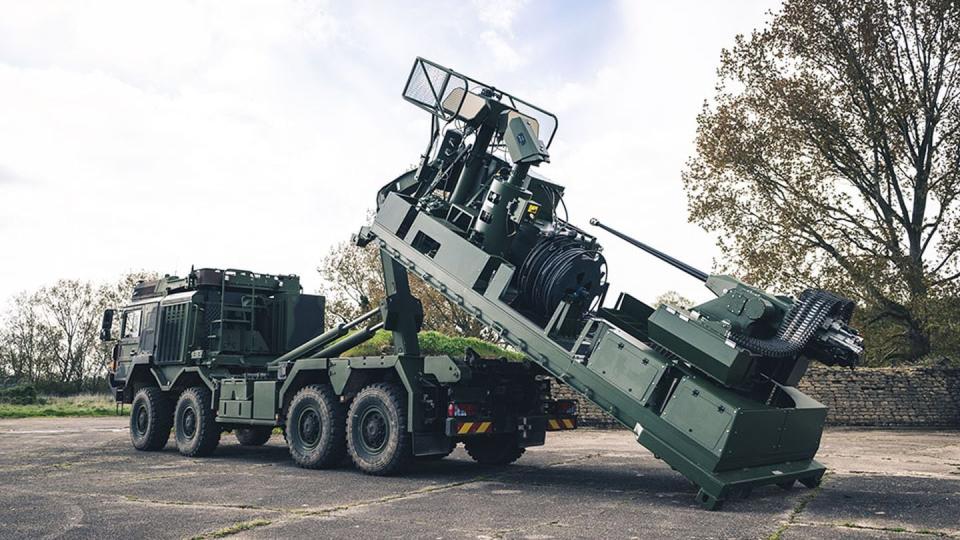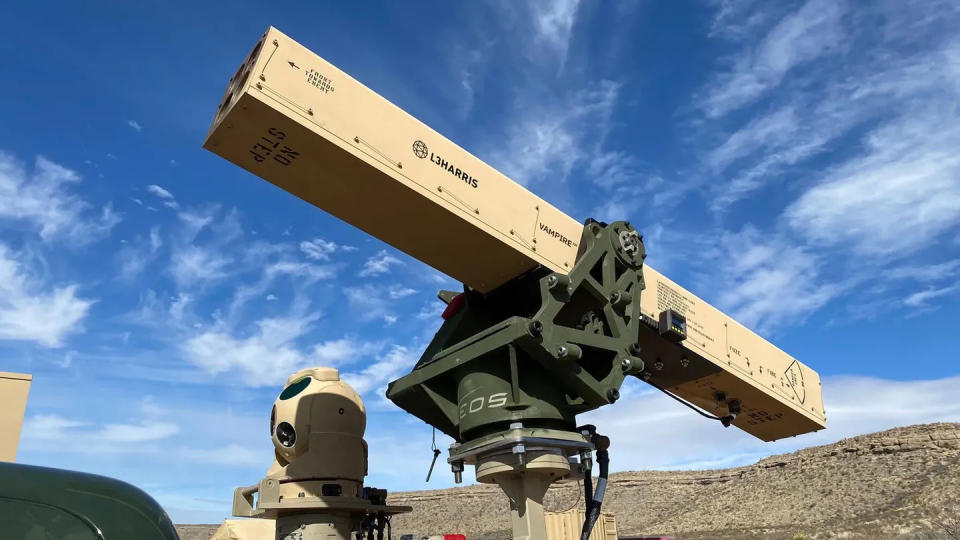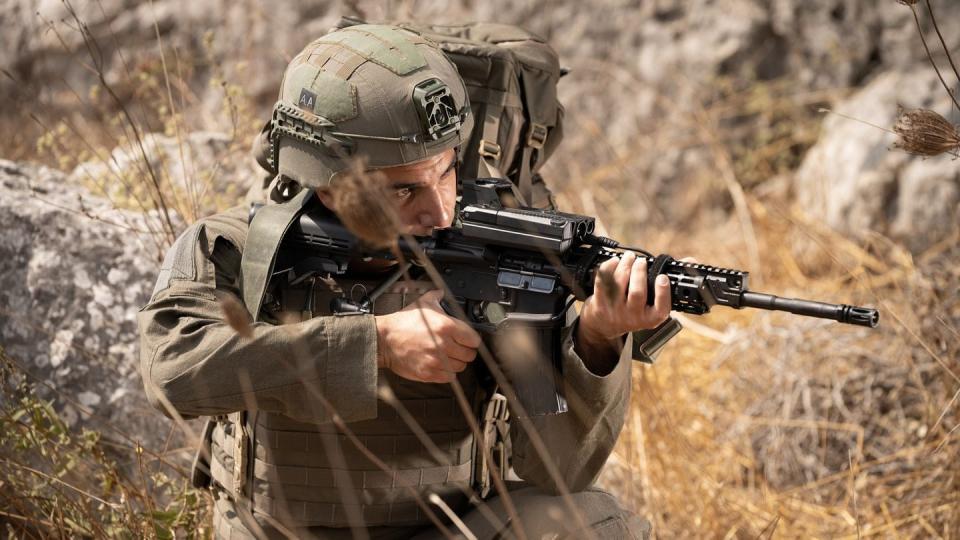Here’s the counter-drone platforms now deployed in Ukraine
When it comes to defending mobile infantry units, defense installations, and strategic locations, high-tech Counter-Unmanned Aerial Systems, or C-UAS, are in increasingly high demand.
Both Ukraine and Russia have used relatively inexpensive UAS to destroy multi-million-dollar tanks, air defenses, helicopters and aircraft. Other drones, armed only with hand grenades, have taken out numerous infantry elements. Though large air defense platforms such as the NASAMS and Patriot SAM systems are important, this exponential rise in small-drone warfare has led to C-UAS platforms becoming an absolute necessity in combat.
Pentagon awards $40M ‘Vampire’ contract for Ukraine’s drone defenses
Ukraine lags behind Russia in electronic warfare, giving the defense industry an opportunity to test and develop innovative new systems in response to the rise in UAS use. Ukrainian soldiers are primarily engaging Russian loitering munitions such as the Zala/Kalashnikov Lance-3 or Iranian Shahed-136 “kamikaze drones” which have hit buildings, armored vehicles and troops on the ground. NATO member states, in collaboration with defense companies, have supplied Ukraine with the latest in C-UAS technology in hopes of providing an edge on the battlefield and in protecting the lives of soldiers and civilians.
There are several categories of C-UAS systems, and drone technology is rapidly evolving.
Skywiper drone mitigation
The Skywiper and it’s many counterparts either employ radio frequency jamming or GNSS jamming, which disrupts a drone’s connection to a GPS satellite link. These weapons are often handheld, and hundreds of various types of jamming devices have been created.
Lithuania recently delivered thousands of the Skywiper Electronic Drone Mitigation 4 System (EDM4S) and the Skywiper Omni. NT Service developed these devices to interrupt the RF control and navigation systems in drones, causing them to lose control. These jamming devices have seen widespread use in Ukraine.With a range of 3-5 kilometers (1.7-3.1 miles) and a weight of only 6.5 kilograms (14.3 pounds), the EDM4S has proven to be easy to use and can be widely deployed with mobile units.
However, for RF and GNSS systems to be effective, they often must have a direct line of sight to their target and sometimes have difficulty tracking drones moving in erratic, unpredictable patterns. Jamming systems also assume that the drones they are targeting use RF or GNSS signals. An increasing number of drones are being designed to operate in GPS-denied environments, making current jamming weapons ineffective.
Terrahawk Paladin system
Many other C-UAS systems in Ukraine employ projectiles to shoot down incoming drones. The U.K. included an MSI-DS TERRAHAWK PALADIN, a Very Short-Range Air Defense (VSHORAD) system, in its recent $122 million military assistance package. Utilizing a 30mm Mk44 Bushmaster II autocannon, the TERRAHAWK can be operated remotely by a crew of two, work in conjunction with up to six other VSHORADs, and engage targets up to 3km away using XM1211 High Explosive Proximity-fused (HE-P) ammunition. Similar systems include the German SKYNEX.

Although these systems can be transported, they are limited due to their “fixed” nature and are best suited to defending cities and strategic locations.
Slinger C-UAS system
Other C-UAS platforms are mobile and intended the be mounted on trucks and armored vehicles.
Electric Optic Systems based in Australia recently sent 160 of its Slinger counter-drone systems to Ukraine. Using a Bushmaster M230LF 30 x 113mm cannon, coupled with proximity fused, high explosive fragmentation rounds, the Slinger can automatically track and eliminate moving targets beyond 800 meters. It can be mounted on the M113 APC or MRAP-like platforms and is valued at $1.55 million per unit.
Cortex Typhoon
Kongsberg received a GBP 56 million contract for the CORTEX Typhon C-UAS system. This incorporates Kongsberg’s Remote Weapon Station (RWS) and the CORTEX Integrated Combat Solution (ICS) which modifies various calibers of machine guns, enabling these weapons to be remotely operated and identify and track targets. Along with these systems, Norway donated Dingo 2 armored vehicles.
L3Harris’ VAMPIRE
The U.S. transferred 14 Vehicle Agnostic Modular Palletized ISR Rocket Equipment (VAMPIRE) systems to Ukraine. These did not come from existing stocks but were contracted through L3Harris Technologies Inc. This relatively low-cost system can be installed on a vehicle within a few hours, equipping it with four 70mm APKWS rockets or similar laser-guided munitions.

While successful, these three systems and their many counterparts are only as effective as their detection and targeting technology, and as UAS tech continues to improve, drones are becoming stealthier and more difficult to track. Most systems also consistently fail to defend against drone “swarms,” and can only engage a limited number of targets in the relatively short range these weapons systems are effective.
Smartshooter
Some technologies modify existing weapons to be more capable in targeting drones. Israel has provided Ukraine with Smartshooter or “Smash” fire control systems, enabling the users of traditional small arms to eliminate fast-moving drones using imaging processing software and tracking algorithms in both day and night conditions.

These optics, if widely deployed, could allow mobile units of soldiers to defend themselves from UAS threats without the need for support from the aforementioned systems that must be mounted on armored vehicles. While proving useful, these attachments are also limited by their operators’ ability to recognize and quickly engage incoming drones – no easy feat.
Improvement needed
The use of small, often homemade drones has become a defining characteristic of the war in Ukraine. Inevitably, we should expect to see and steep rise in demand for UAS and C-UAS platforms, as well as the use of other autonomous systems in regional conflicts. At the same time, C-UAS systems universally need improvement to increase their effectiveness.
Combat use in Ukraine will contribute to this. However, current C-UAS systems will continue to prove inadequate in the face of faster, quieter, more maneuverable, less-detectable, swarms of drones. Armed drones can be produced and employed for significantly less compared to the cost of C-UAS systems. In the coming years, we will inevitably see an increasing need for inexpensive, compact, portable, defense systems that can be deployed in large numbers to terminate UAS threats.
Ethan Walton is a graduate of NYU’s MA in International Relations and currently maintains the Ukraine Weapons Tracker at The Forum on the Arms Trade, a network of civil society experts and a point of contact for strengthening public efforts to address the humanitarian, economic and other implications of arms transfers, security assistance, and weapons use.

